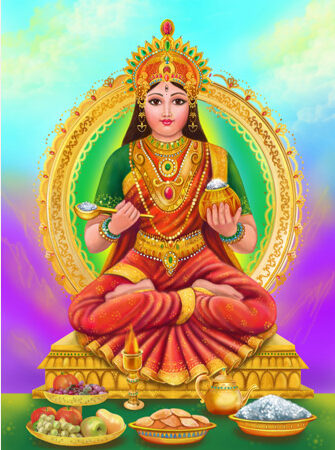Annapurna is the Hindu goddess of abundance who brings plenty and satisfaction in all aspects of life.
She brings abundance into a person’s home and life. Annapurna is considered one of the aspects of Adi Shakti—the primordial cosmic energy responsible for sustaining life and fostering abundance.
She is capable of quenching hunger and thirst, serving as a divine source of nourishment.

Connecting with this aspect of Annapurna ensures that an individual no longer feels a sense of scarcity. Through prayer and meditation inner state of deficit transforms into a state of abundance and inner happiness, which naturally attracts prosperity into one’s surrounding life.
Negative traits such as greed, avarice, and envy are often a consequence of an inner sense of deficit, which manifests as constant inadequacy, lack of material wealth , absence of self esteem and love. Annapurna is deity of this inner abundance, contentment and satisfaction which makes life wholesome including material wealth and happiness.

Stories of Annapurna are replete with lives of wealthy people who had no joy in their lives and projected negativity, anger till they were touched with the enlightenment of Annapurna.
Adi Shakti is the primordial energy that manifests in various forms, including as Annapurna, to bring sustenance, abundance, and other forms of divine nourishment into the world.
Aligning oneself with Annapurna’s aspect helps attain inner satisfaction, feel fulfilled, recognize one’s worth in the world, sense the support of the divine, and effortlessly attract and manifest abundance in any circumstance.
In traditional iconography, Annapurna is depicted as a young goddess with a face resembling the full moon. She is shown with three eyes and either two or sometimes four hands. She is adorned in beautiful garments and golden jewelry and sits on a throne. In one hand, she holds a bejeweled bowl filled with food, and in the other, a spoon to distribute the food to her devotees. The bowl filled with grains symbolizes the abundance of food that she offers to all her children. In some depictions, Lord Shiva stands beside her with a begging bowl in his hands, asking Annapurna for the food that provides the energy (Shakti) required for attaining knowledge and enlightenment.
The importance of this icon is that there is no plentifullness without giving with the other hand. Accumulation is not wealth or abundance but poverty of spirit. Only giving is divine and that is why Shiva himself stands with a bowl – representing the needy. In Hindu culture compassionate giving is a divine act and wholeness of human beings is achieved not through self enrichment but through sharing and giving.
Annapurna serves not only as the goddess of material abundance but as a divine force providing spiritual nourishment. She symbiolizes the oneness of spiritual and material aspects of life, epitomizing multifaceted nature of human achievement in Hindu mythology.
One legend concerning the origin of Annapurna narrates a tale where Lord Shiva told his consort, Goddess Parvati, that the world is an illusion, and that food is part of this illusion called Maya.
The Divine Mother, who is also worshipped as the manifestation of all material aspects, including food, decided to demonstrate the importance of her role by vanishing from the world. Her disappearance caused time to stop, rendering the earth barren. There was no food anywhere, and all beings suffered from hunger. Witnessing this calamity, Parvati reappeared in the sacred city of Kashi and began distributing food to all those in need.
Shiva, hearing about this and realizing that he was incomplete without Shakti (the divine feminine energy), presented himself before her with a begging bowl. He acknowledged that the material world cannot be dismissed as mere illusion. Food cannot be discarded as a simple illusion either, as it is essential for nourishing the physical body, which houses the Atman (soul).
This legend emphasizes the fundamental interplay between the material and spiritual realms, illustrating that neither can be negated or ignored. It underlines the vital role of Annapurna as not just the goddess of material abundance, but also as the divine force nourishing both the body and the soul.
The core idea of Annapurna Yoga is to help individuals attain harmony in life, connect with their inner source of strength, and achieve a state of inner abundance and happiness.
Simultaneously, this practice enhances material well-being, success in life bringing abundance while harmonizing the body and mind. Annapurna Yoga improves physical fitness and mental health, and significantly raises energy levels so that the student has the tools to manifest full spiritual, emotional and physical potentials in life. It empowers students in tackling complex life challenges, unleashes hidden talents and inner potential, and offers the strength to dramatically improve all aspects of life.



